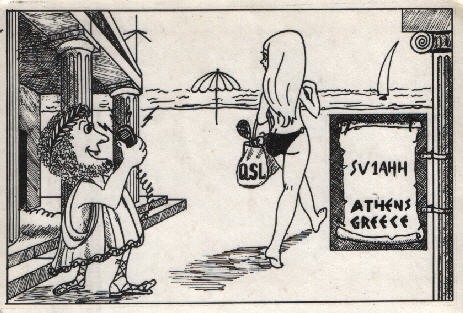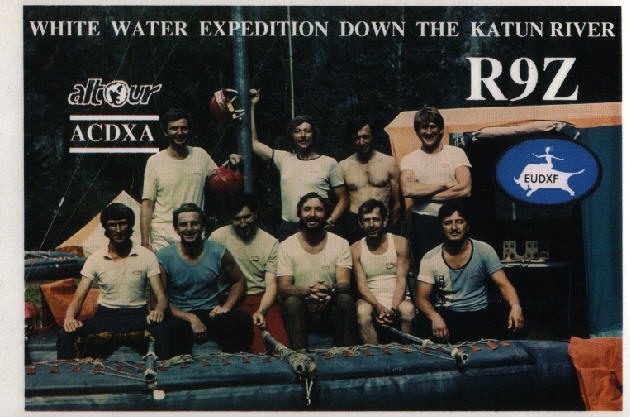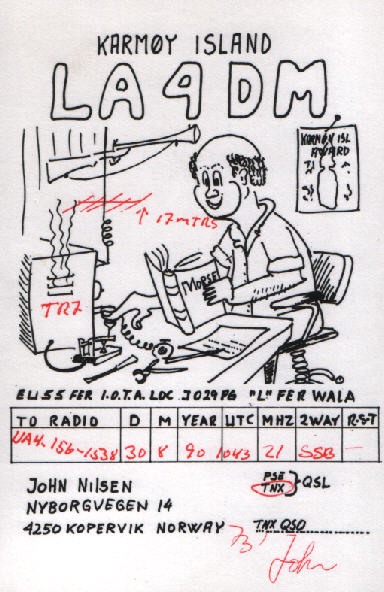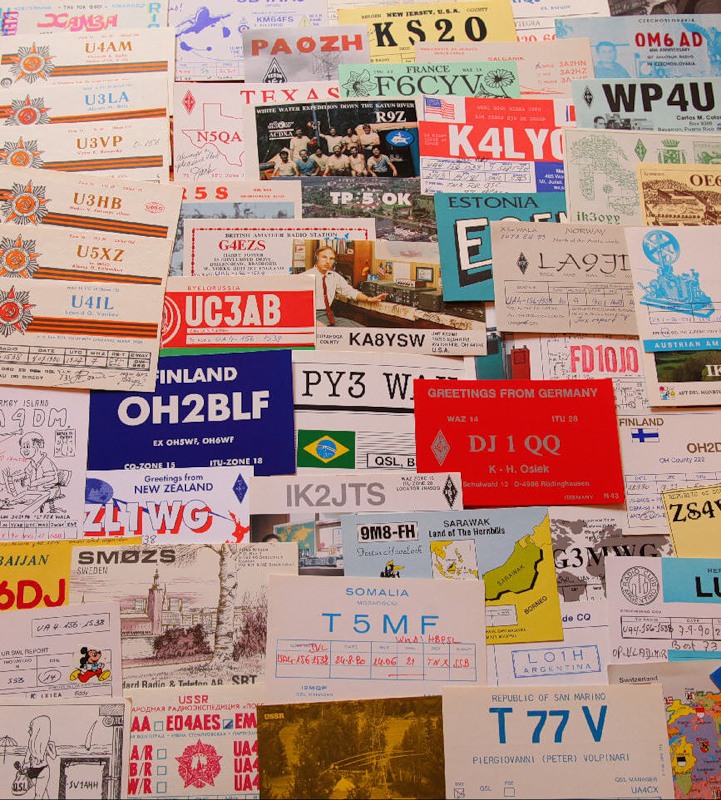Amateur HF radio communication, part 1 - the observer
A rare nowadays, almost gone concept “radio amateur”, “KV radio sportsman” was intriguing some 15-20 years ago. Enthusiasts with a soldering iron in their hands sorted out the schemes, exchanged ideas, new designs of receiving-transmitting devices. Showed remarkable ingenuity in the search for the necessary radio components in conditions of total shortage.

In the conditions when a regular landline phone was not in every apartment, the ability to communicate, communicate with thousands of radio amateurs and discover the world was a real miracle. That is how I joined this big family.
')
The hobby began with a trip to the local DOSAAF club where there was a radio school, a radio club and a collective radio station RZ4AWB. It was there that I was interested in the versatility of amateur communication on HF waves. This is just work on the air, and hunting for DX stations (rare and distant), monitoring the work of radio expeditions and participation in competitions. And just the opportunity to connect with different continents of the globe. The mere thought of such a possibility agitated the imagination.
The categories of shortwave radio amateurs are divided into two large groups - those who conduct radio communication sessions (QSO) and observers. Undoubtedly, to get acquainted with radio communications, it is easier to start with observations, gain experience, study how experienced radio amateurs work, and comprehend radio etiquette.
It is as an observer that I began my journey through the radio waves. Having written the application and received your first call sign of the observer. UA4-156-1538! Practically on the same day, the first records about radio observations appeared in the hardware log, a little later the joy of the first QSL cards received.

Looking ahead, I would say that the hobby of HF communication, the practice of the radio operator and the study of receiving equipment and antenna facilities gave me invaluable knowledge, which greatly helped me while serving in the Russian armed forces in the communications division.
Generally speaking, radio sport involves several areas: sports telegraphy, sports radio direction finding (“fox hunting”), all-around radio operators, radio communication on HF and VHF. It is about the last species that I will try to tell a little.
The equipment of an amateur HF radio station can consist of both separate receiver and transmitter units, as well as an integrated device called a transceiver. As well as their combinations, which is not uncommon especially when participating in competitions. Plus antenna economy. As a rule, the transceiver is designed for all amateur radio communication ranges and covers the frequency range of 0.1 - 30 MHz, but for beginners amateur and 1-2 range devices will be enough to understand the basics, but it is desirable to have a multi-band receiver. The frequency of the receiver and transmitter in the transceiver coincide, which simplifies the operational work on the air.
Amateur equipment can be assembled independently, but this requires the appropriate qualifications of the radio amateur, experience in building devices of this class, and measuring equipment. As with any business, workplace equipment has a decisive role.
The observer in this regard requires only a receiver, but sports results depend on its quality and first of all the sensitivity of the receiving path. I started with a lamp receiver from some military radio station, weighed the device with an excessive amount of power, emphasizing with my armor the strength of the Soviet army. Then, taking on a soldering iron in the magazines "Radio" and "Radio Amateur", more modern receivers were assembled, which immediately affected the quality of the reception.

Of great importance for high-quality work is the antenna economy of the radio amateur. Significant complexity here is the installation and maintenance of a high-quality antenna at a considerable height from the ground, and when using a mast on the roof of a high-rise building, it is also required to obtain permits for installation, which is not always possible in principle. And the neighbors will not be very enthusiastic, unless you yourself live on the top floor. I heard that some enthusiastic radio amateurs even changed their place of residence because of their hobbies and the ability to fully engage in radio communications.
Radio amateurs install antennas on the spatial capabilities and compliance with the selected range of work on the air. An important aspect is the ability to install the mast, but significantly increases the cost and not everywhere available. Common antennas are recognized as a half-wave dipole, an inverted V antenna (a kind of dipole), a triangle or square with a perimeter equal to the wavelength, a “grind plane” groung plane. Most other types of antennas are derived. Also important is the orientation of the antenna in space and the absence of obstacles in the form of high-rise buildings of power lines.
The main types of work on the air are SSB - telephone single-band modulation and CW - telegraph with amplitude modulation (you need to know Morse code), but together with a computer such types of communication as RTTY teletypewriter, packet communication and slow-scan television (SSTV) become available. Each type of radio communication corresponds to a particular HF category of radio amateur. In Russia, the categories of radio amateurs are divided into 4 classes and depend on the results of qualifying examinations and the availability of equipment for working in the respective frequency ranges, as well as participation in competitions, the presence of diplomas. The transition to a higher category is possible no more than once a year.
NAM - shortwave radio amateur
CALL SIGN - the radio call sign
BAND - frequency range
LOG BOOK - hardware log
CQ - attention to all
DX - rare radio station
73! - Best wishes, transmitted at the end of the message
Radio amateur codes are not limited to the above, their total number amounts to hundreds, and often used ones are limited to dozens. When operating as a telegraph (CW), the length of each transmitted word is important, therefore, the notation called the Q code is entered. The Q code is also used when operating the telephone (SSB) as a convenient international abbreviation of terms.
Examples of Q code:
QSL - radio acknowledgment receipt card
QSO - radio session
QTH - place of residence
QRL - the query whether the frequency is free
QRT - stop transmission
QRA - what is the name of your radio station?
QRZ - who is calling me?
QUA - Do you have news?
1810 - 2000 kHz 1.8 MHz or 160 meters
3500 - 3800 kHz 3.5 MHz or 80 meters
7000 - 7200 kHz 7 MHz or 40 meters
10100 - 10150 kHz 10 MHz or 30 meters
14000 - 14350 kHz 14 MHz or 20 meters
18068 - 18318 kHz 18 MHz or 17 meters
21000 - 21450 kHz 21 MHz or 15 meters
24890 - 25140 kHz 24 MHz or 12 meters
28000 - 29700 kHz 28 MHz or 10 meters
Radio amateurs have 9 short-wave (HF) bands, the main ones are the 160, 80, 40, 20, 15 and 10-meter bands, which corresponds to the frequency ranges: 1.81 - 2.0 MHz, 3.5 - 3.8 MHz, 7.0 - 7.2 MHz, 14.0 - 14.35 MHz, 21.0 - 21.45 MHz and 28.0 - 29.7 MHz
Beginning athletes have access to the 1.8 MHz range, it is in him that the formation of a short-wave occurs. As skill increases, a radio amateur can move to a new category, up to the resolution of work on all selected ranges and the maximum allowable transmitter power.
Each frequency range has its own signal transmission properties; therefore, the communication range strongly depends on the season, time of day and level of solar activity. Minimal solar activity, winter and night are more favorable for the possibility of long-distance communications on HF in the 160/80 meter range.
Individual unique callsign (CALL SIGN) - the basis of the basics for working on the air. It is required for the unambiguous identification of a radio amateur or an athlete, in a word it is a business card necessary for radio communication. Each call sign consists of a prefix and a suffix of Latin letters and numbers. The prefix corresponds to the country of the radio amateur, and the suffix is the individual component of the call sign. For example, UA4AAA is the “UA4” prefix for the country and region / zone within the country, the first letter of the “AAA” suffix together with the number 4 in Russia denotes the Volgograd region. The callsign can also be shorter than 6 characters, as a rule, 5-digit callsigns have shortwave 1 category. Special callsigns were issued to participants of the Second World War, periodically issued to members of expeditions. A short call sign has an advantage when speaking / transmitting on the air when participating in competitions. Sometimes extended characters are added to the callsign through the slash, indicating work outside the main location, for example, from the side of a car, ship or on a hike.
For radio amateurs, observers made their own format of callsigns such as UA4-156-1538. Here, the prefix "UA4-156" denotes the country and region, and "1538" - the individual number of the observer. The length of the observer’s call sign does not matter much, as it is used off-air to receive QSL, diplomas, and participation in competitions.

As well as on the ships, the ship's log is kept by the short-wave radio amateur should have a hardware magazine of the radio station. In it, he records the communication sessions that have taken place, and the observers record the fact of the observation of radio communications between radio stations indicating the time, call signs, and quality of communication. As a rule, the operator’s name, data about the interlocutor’s equipment, the place of broadcasting and the purpose if it is an expedition is recorded in the comments. The hardware log can be kept both in a usual notebook, and on a computer.

The fact of conducting a radio communication session or observation can be confirmed by a QSL card — a paper postcard with information about the radio station and a call sign. Data on the request / receipt of QSL are recorded in the station's hardware log. A QSL card can be from the simplest (stamp on a serial card or on the card requesting) to an individual customized in the printing house, one or two-sided. Receiving and sending QSL occurs through the QSL bureau of the radio clubs of the radio sport federation.

What are QSL cards for? QSL is a confirmation of the fact of radio communication (possibly with a very remote radio amateur), which counts towards the corresponding radio sport diplomas. And sometimes just an interesting postcard and the memory of an interesting radio communication session, a new opportunity to study geography and history. Many radio amateurs, especially from far-abroad countries, have a station equipment on a QSL card, and some of the operator’s photos. Therefore, the QSL card is rather the face of a radio amateur.
Thank you for your attention and 73!

In the conditions when a regular landline phone was not in every apartment, the ability to communicate, communicate with thousands of radio amateurs and discover the world was a real miracle. That is how I joined this big family.
')
The hobby began with a trip to the local DOSAAF club where there was a radio school, a radio club and a collective radio station RZ4AWB. It was there that I was interested in the versatility of amateur communication on HF waves. This is just work on the air, and hunting for DX stations (rare and distant), monitoring the work of radio expeditions and participation in competitions. And just the opportunity to connect with different continents of the globe. The mere thought of such a possibility agitated the imagination.
The categories of shortwave radio amateurs are divided into two large groups - those who conduct radio communication sessions (QSO) and observers. Undoubtedly, to get acquainted with radio communications, it is easier to start with observations, gain experience, study how experienced radio amateurs work, and comprehend radio etiquette.
It is as an observer that I began my journey through the radio waves. Having written the application and received your first call sign of the observer. UA4-156-1538! Practically on the same day, the first records about radio observations appeared in the hardware log, a little later the joy of the first QSL cards received.

Looking ahead, I would say that the hobby of HF communication, the practice of the radio operator and the study of receiving equipment and antenna facilities gave me invaluable knowledge, which greatly helped me while serving in the Russian armed forces in the communications division.
Generally speaking, radio sport involves several areas: sports telegraphy, sports radio direction finding (“fox hunting”), all-around radio operators, radio communication on HF and VHF. It is about the last species that I will try to tell a little.
Hardware part of amateur radio station
The equipment of an amateur HF radio station can consist of both separate receiver and transmitter units, as well as an integrated device called a transceiver. As well as their combinations, which is not uncommon especially when participating in competitions. Plus antenna economy. As a rule, the transceiver is designed for all amateur radio communication ranges and covers the frequency range of 0.1 - 30 MHz, but for beginners amateur and 1-2 range devices will be enough to understand the basics, but it is desirable to have a multi-band receiver. The frequency of the receiver and transmitter in the transceiver coincide, which simplifies the operational work on the air.
Amateur equipment can be assembled independently, but this requires the appropriate qualifications of the radio amateur, experience in building devices of this class, and measuring equipment. As with any business, workplace equipment has a decisive role.
The observer in this regard requires only a receiver, but sports results depend on its quality and first of all the sensitivity of the receiving path. I started with a lamp receiver from some military radio station, weighed the device with an excessive amount of power, emphasizing with my armor the strength of the Soviet army. Then, taking on a soldering iron in the magazines "Radio" and "Radio Amateur", more modern receivers were assembled, which immediately affected the quality of the reception.

Of great importance for high-quality work is the antenna economy of the radio amateur. Significant complexity here is the installation and maintenance of a high-quality antenna at a considerable height from the ground, and when using a mast on the roof of a high-rise building, it is also required to obtain permits for installation, which is not always possible in principle. And the neighbors will not be very enthusiastic, unless you yourself live on the top floor. I heard that some enthusiastic radio amateurs even changed their place of residence because of their hobbies and the ability to fully engage in radio communications.
Radio amateurs install antennas on the spatial capabilities and compliance with the selected range of work on the air. An important aspect is the ability to install the mast, but significantly increases the cost and not everywhere available. Common antennas are recognized as a half-wave dipole, an inverted V antenna (a kind of dipole), a triangle or square with a perimeter equal to the wavelength, a “grind plane” groung plane. Most other types of antennas are derived. Also important is the orientation of the antenna in space and the absence of obstacles in the form of high-rise buildings of power lines.
The main types of work on the air are SSB - telephone single-band modulation and CW - telegraph with amplitude modulation (you need to know Morse code), but together with a computer such types of communication as RTTY teletypewriter, packet communication and slow-scan television (SSTV) become available. Each type of radio communication corresponds to a particular HF category of radio amateur. In Russia, the categories of radio amateurs are divided into 4 classes and depend on the results of qualifying examinations and the availability of equipment for working in the respective frequency ranges, as well as participation in competitions, the presence of diplomas. The transition to a higher category is possible no more than once a year.
Amateur and Q codes
NAM - shortwave radio amateur
CALL SIGN - the radio call sign
BAND - frequency range
LOG BOOK - hardware log
CQ - attention to all
DX - rare radio station
73! - Best wishes, transmitted at the end of the message
Radio amateur codes are not limited to the above, their total number amounts to hundreds, and often used ones are limited to dozens. When operating as a telegraph (CW), the length of each transmitted word is important, therefore, the notation called the Q code is entered. The Q code is also used when operating the telephone (SSB) as a convenient international abbreviation of terms.
Examples of Q code:
QSL - radio acknowledgment receipt card
QSO - radio session
QTH - place of residence
QRL - the query whether the frequency is free
QRT - stop transmission
QRA - what is the name of your radio station?
QRZ - who is calling me?
QUA - Do you have news?
Amateur frequency distribution band
1810 - 2000 kHz 1.8 MHz or 160 meters
3500 - 3800 kHz 3.5 MHz or 80 meters
7000 - 7200 kHz 7 MHz or 40 meters
10100 - 10150 kHz 10 MHz or 30 meters
14000 - 14350 kHz 14 MHz or 20 meters
18068 - 18318 kHz 18 MHz or 17 meters
21000 - 21450 kHz 21 MHz or 15 meters
24890 - 25140 kHz 24 MHz or 12 meters
28000 - 29700 kHz 28 MHz or 10 meters
Radio amateurs have 9 short-wave (HF) bands, the main ones are the 160, 80, 40, 20, 15 and 10-meter bands, which corresponds to the frequency ranges: 1.81 - 2.0 MHz, 3.5 - 3.8 MHz, 7.0 - 7.2 MHz, 14.0 - 14.35 MHz, 21.0 - 21.45 MHz and 28.0 - 29.7 MHz
Beginning athletes have access to the 1.8 MHz range, it is in him that the formation of a short-wave occurs. As skill increases, a radio amateur can move to a new category, up to the resolution of work on all selected ranges and the maximum allowable transmitter power.
Each frequency range has its own signal transmission properties; therefore, the communication range strongly depends on the season, time of day and level of solar activity. Minimal solar activity, winter and night are more favorable for the possibility of long-distance communications on HF in the 160/80 meter range.
Call sign system
Individual unique callsign (CALL SIGN) - the basis of the basics for working on the air. It is required for the unambiguous identification of a radio amateur or an athlete, in a word it is a business card necessary for radio communication. Each call sign consists of a prefix and a suffix of Latin letters and numbers. The prefix corresponds to the country of the radio amateur, and the suffix is the individual component of the call sign. For example, UA4AAA is the “UA4” prefix for the country and region / zone within the country, the first letter of the “AAA” suffix together with the number 4 in Russia denotes the Volgograd region. The callsign can also be shorter than 6 characters, as a rule, 5-digit callsigns have shortwave 1 category. Special callsigns were issued to participants of the Second World War, periodically issued to members of expeditions. A short call sign has an advantage when speaking / transmitting on the air when participating in competitions. Sometimes extended characters are added to the callsign through the slash, indicating work outside the main location, for example, from the side of a car, ship or on a hike.
For radio amateurs, observers made their own format of callsigns such as UA4-156-1538. Here, the prefix "UA4-156" denotes the country and region, and "1538" - the individual number of the observer. The length of the observer’s call sign does not matter much, as it is used off-air to receive QSL, diplomas, and participation in competitions.
Hardware log and QSL

As well as on the ships, the ship's log is kept by the short-wave radio amateur should have a hardware magazine of the radio station. In it, he records the communication sessions that have taken place, and the observers record the fact of the observation of radio communications between radio stations indicating the time, call signs, and quality of communication. As a rule, the operator’s name, data about the interlocutor’s equipment, the place of broadcasting and the purpose if it is an expedition is recorded in the comments. The hardware log can be kept both in a usual notebook, and on a computer.

The fact of conducting a radio communication session or observation can be confirmed by a QSL card — a paper postcard with information about the radio station and a call sign. Data on the request / receipt of QSL are recorded in the station's hardware log. A QSL card can be from the simplest (stamp on a serial card or on the card requesting) to an individual customized in the printing house, one or two-sided. Receiving and sending QSL occurs through the QSL bureau of the radio clubs of the radio sport federation.

What are QSL cards for? QSL is a confirmation of the fact of radio communication (possibly with a very remote radio amateur), which counts towards the corresponding radio sport diplomas. And sometimes just an interesting postcard and the memory of an interesting radio communication session, a new opportunity to study geography and history. Many radio amateurs, especially from far-abroad countries, have a station equipment on a QSL card, and some of the operator’s photos. Therefore, the QSL card is rather the face of a radio amateur.
Thank you for your attention and 73!
Source: https://habr.com/ru/post/127862/
All Articles